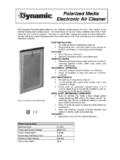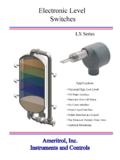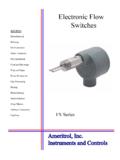Transcription of The ABC's of electronic fluorescent ballasts - …
1 The ABC's of electronic fluorescent ballastsA guide to fluorescent ballasts 2 The ABC's of electronic fluorescent Ballasts100 years of brighter,more efficient lighting. The first fluorescent lamp was patented over 100 years ago by American inventor, Peter Cooper Hewitt. Cooper Hewitt s low pressure mercury arc lamp is the direct parent of today s modern fluorescent lights. Far more efficient than incandescent lamps, fluorescent lamps use electricity to excite molecules of Argon or Krypton together with mercury vapor to create luminescence. Unlike incandescent lamps, a fluorescent lamp cannot be connected directly to electric lines. They require ballasts to stabilize the flow of current or else they quickly become inoperable. A ballast provides the starting voltage for a fluorescent lamp and limits the current passing through it. The ballast also provides proper electrode or filament most of the last century, electromagnetic ballasts , sometimes referred to as core-and-coil or magnetic ballasts , were the only fluorescent lamp ballasts available.
2 Since 1988, when they first began to penetrate the market, electronic ballasts have proven themselves not only as workhorses of efficiency but also as a catalyst for revolutionizing fluorescent lighting system design and specification. This guide will give you a greater understanding of electronic ballasts , the great many options they offer and the benefits of using various types of electronic ballasts in designing more energy-efficient, economic, innovative and user-friendly lighting systems. ContentsUnderstanding Light Sources Energy Efficient fluorescent Lamps ..3 electronic Ballast Fundamentals Star ting Method ..5 Circuits ..6 The Language of ballasts ..6 Controlability ..9 New Applications in fluorescent Lighting ..9 Lamp Ballast System Applications What Do I Need the Lighting System to Deliver ..11 Reference Section Legislative ..13 Regulatory Requirements.
3 14 Innovation, Reliability and Unrivalled Product ..15 Philips Lighting Electronics Has a Family of Ballast for Every Application ..16 Ballast Feature Comparison (fixed light output) Ballast Feature Comparison (controllable) ..17 Glossary ..18 3 The ABC's of electronic fluorescent BallastsEnergy-Efficient fluorescent LampsFluorescent lamps operate at cooler temperatures thanincandescent lamps, and convert electrical energy to light more efficiently. Their operation relies upon an electrical arc passing between two electrodes, one on each end of the lamp. This arc passes through a glass tube coated with phosphor in a mixture of vaporized mercury and purified gases mainly Argon or Krypton. The resulting ultra-violet waves react with the phosphor to produce a glow (fluorescence) and emit visible light. In evaluating the suitability of various fluorescent lamps for particular applications, it is important to understand some basic lamp characteristics and Lamps TypesFluorescent lamps sold in the United States today areavailable in a wide variety of shapes and sizes ranging from miniature versions, rated at 4W, 6" in length and 5/8" diameter, to 215W, 96" long and 2" in diameter.
4 Commercially available fluorescent lamp types include T12, T8, and T4 compact and T5-linear and compact. Base types include bi-pin, single pin, several compact bases and recessed double lamps, which can be operated electronically, butare typically operated by electromagnetic ballasts , are11/2" in diameter are now outsold by T8 lamps whichhave a 1" diameter. T8 lamps typically operate by electronic ballasts , but may also operate using magneticballasts. T8 lamps produce a better quality light andare dual rated for rapid or instant start operation, whichmaximizes application flexibility. T4 compact lamps areUnderstanding Light SourcesIn order to properly evaluate, specify, purchase or install a lighting system, it is important to understandthe variety of lamps available for this purpose in the marketplace " diameter, high lumen output, lamps developedto replace incandescent lamps in many down lighting applications.
5 T5 lamps, 5/8" in diameter, provide some application flexibility and enhanced optic design due to its smaller Light OutputLamp Light Output is measured in lumens. fluorescent lamps are measured in initial lumens or in design lumens. Initial lumens is a measure of the amount of light that the lamp produces after about 100 hours of operation. Design lumens tells you the amount of light that the lamp produces after it has operated for approximately 40% of its rated light output from a fluorescent lamp diminishes as the lamp is used a process known as Lamp Lumen Depreciation a lamp s design lumens (or mean lumens) are always lower than its initial lumens. Lumen maintenance refers to the rate at which light output declines over time and lumen maintenance percentages are typically based on light output at 40% of a lamp s rated per WattLumens per Watt is a rating of a lamp s light output in relation to the current passing through it or the watts it uses.
6 The more efficient a lamp, then the more lumens it will produce per watt of power consumed. The measurement LPW is also referred to as lamp "efficiency." 4 The ABC's of electronic fluorescent BallastsCrest FactorLamp manufacturers use crest factor to determineballast performance as it relates to lamp life. Lamp Current Crest Factor is a measurement of current supplied by a ballast to start and operate the lamp. It is basically the ratio of peak current to RMS (average) current. High crest factor currents may cause the lamp electrodes to wear out faster, reducing lamp life. Crest factor requirements are regulated by ANSI (American National Standards Institute) standards and specified by lamp manufacturers. For rapid start and instant start T8 lamps the ratio is maximum, and for instant start slimline lamps, it is LampsEven though nearly 90% of the energy consumed by incandescent lamps is dissipated as heat, they are still prevalent in most American homes and are used throughout business and industry.
7 The operation of incandescent lamps is simple and self-regulating: whenelectricity passes through a lamp filament, it heats the filament until it glows (incandesces) and produces light. The amount of light produced depends on the amount of electrical current passing through the filament. In addition to producing light, the filament also limits the current to safe operating Emitting DiodesCommonly called an LED, a Light Emitting Diode is a semiconductor device that illuminates by the movement of electrons in the material. Unlike incandescent or fluorescent bulbs, LEDs do not have filaments that burn out, so they last many times longer than traditional light sources. LEDs are very small, making them ideal for use as indicator lights or in cell phones and flash lights. Collected together, they can form images on a jumbo television screen or illuminate a traffic light or car taillight.
8 Advances in technology are making LEDs less expensive and brighter, giving them great potential for use as a general lighting source in the Intensity Discharge LampsHigh Intensity Discharge, known as HID, refers to lighting technology that produces light by passing an electric current through a gas or vapor at high pressure. The current produces a high intensity arc or dischargeof light that is very efficient. HID lighting has been used for years in roadway lighting, industrial and warehouse high and low bay applications, and sports arenas and stadiums around the country. The technology is increasingly being used in specialty applications such as automotive Types of LampsPeakIPeakCrest Factor = 5 The ABC's of electronic fluorescent BallastsInstant start electronic ballastsStart lamps without delay (< seconds) or flicker by providing a starting voltage that is sufficiently high to start a discharge through the lamps without the need for heating lamp electrodes.
9 For F32T8 systems, the starting voltage is about 600V. The elimination of electrode heating maximizes energy savings typically saving two watts per lamp compared to rapid start ballasts . Instant start ballastsare best suited for applications with limited switches each day. Lamps operated by instant start ballasts typically operate 10,000 to 15,000 switch cycles before start electronic ballastsStart lamps quickly ( seconds) without flicker by heating the lamp electrodes and simultaneously applying a starting voltage. The starting voltage of about 500V for F32T8 systems is sufficient to start a discharge through the lamps when the electrodes have reached an adequate temperature. Electrode heating continues during operation and typically consumes two watts per lamp. Lamps operated by rapid start ballasts typically operate 15,000 to 20,000 switch cycles before Ballast FundamentalsStarting MethodsWhat does a ballast doProgrammed start electronic ballastsAlso start lamps quickly ( seconds) without flicker.
10 Programmed start ballasts are designed to provide maximum lamp life in frequent lamp starting applications such as in areas where occupancy sensor controls are used. Programmed start electronic ballasts precisely heatthe lamp electrodes, tightly controlling the preheat duration before applying the starting voltage. This enhancement over rapid start ballasts minimizes electrode stress and depletion of emitter material, thereby maximizing lamp life. Lamps operated by programmed start ballasts typically operate up to 50,000 switch cycles before Start is also used for most compact lamp systems and electronic dimming systems to provide proper starting of lamps when starting in the dimmed mode. Philips Advance Optanium ballasts include the first high-efficiency programmed start electronic ballasts to offer the same energy savings as their instant start counterparts without sacrificing lamp all fluorescent lighting systems, the ballast s basic tasks include: Providing the proper voltage to establish an arc between the two electrodes.






